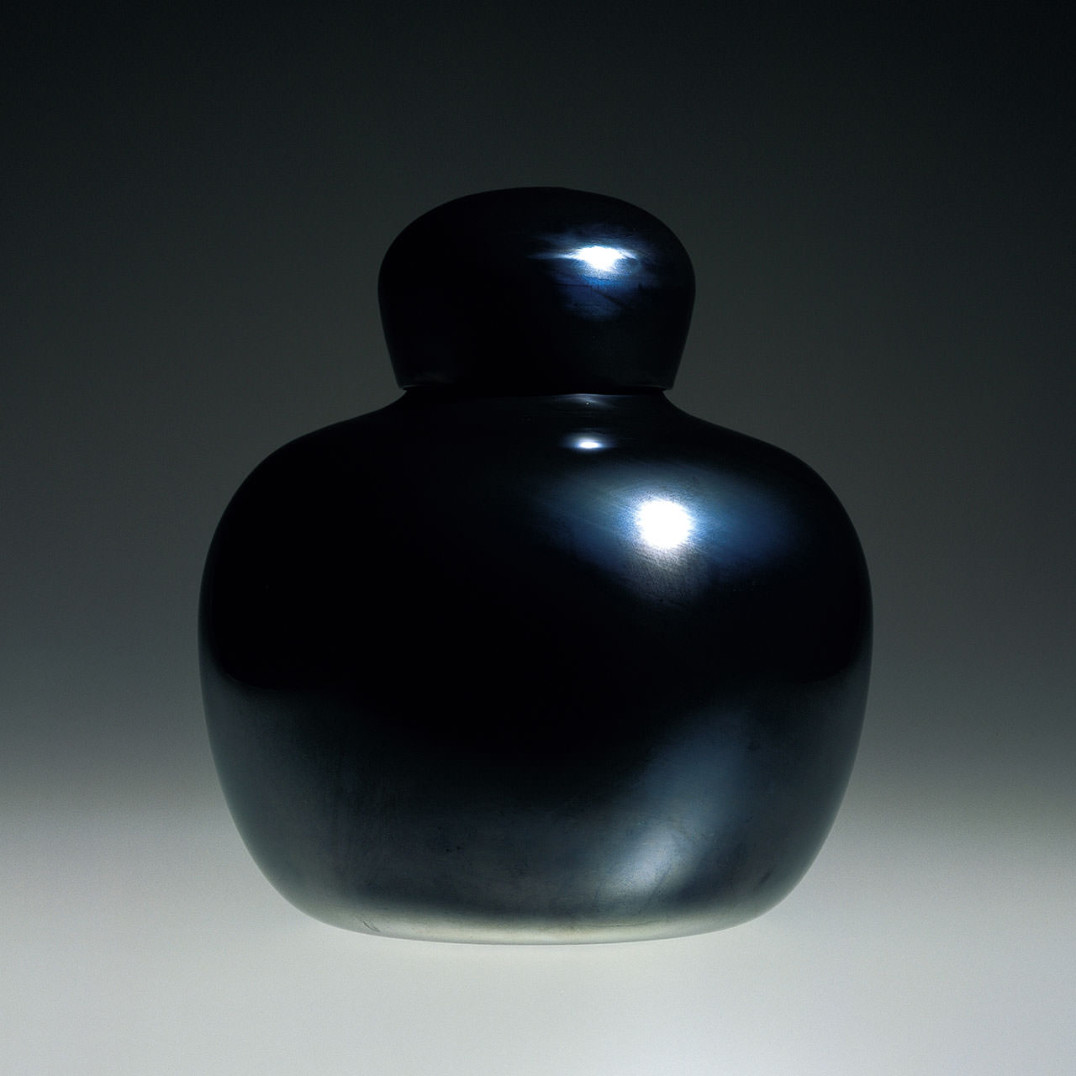
Tobia ScarpaCinese, ca. 1960

Tobia ScarpaCineseVenini & C., ca. 1960
An anthracite black Chinese
ginger jar shaped vessel with a matching lid. The entire vessel is heavily iridized.
Acid stamped:
venini murano ITALIA.
10 1/8 in. high (25.6 cm)
Exhibitions:
2000, New York, Venetian Glass, Museum of Arts & Design;
2001, Milan, Murano: Vetri dalla Collezione Olnick Spanu, Spazio Oberdan.
Bibliography and comparative texts:
Venini, grey catalogue, n. 8555;
Olnick Spanu, 2000, n. 138;
Olnick Spanu, 2001, n. 173.

Tobia Scarpa 1935–
Tobia Scarpa, son of Carlo Scarpa, was born in Venice, where he graduated from the Istituto Universitario di Architettura di Venezia. In 1958, he was invited by Paolo Venini to collaborate in the furnace, following in the footsteps of his father, who had worked with Venini during the '30s and '40s. Tobia Scarpa designed new collections for Venini even after the death of its founder, creating refined blown glass pieces exemplified by the essential quality of their design. The most successful vessels were his large Battuti vessels, the Occhi and Murrine series, for which he reinterpreted ancient Roman glass techniques. As an architect and designer, together with his wife, Afra, he has collaborated with many companies—Cassina, B & B Italia, Flos, Molteni & C., to name a few—in creating works that belong to the best tradition of Italian design. During the '80s, he and his wife designed several glass collections for VeArt.

Venini & C. 1932–2001
In 1932, when both Martinuzzi and Zecchin left the company, Paolo Venini changed the name from Vetri Soffiati Muranesi Venini & Co. (V.S.M. Venini & Co.) to Venini & C.. Milanese architect Tommaso Buzzi became the new artistic director. After 1934, artistic direction was taken on by Carlo Scarpa, who designed most of the company's production through 1947. Side by side with Venini, who often intervened personally in design, Scarpa created numerous collections of objects characterized by refined colors. After World War II, Venini & C. sought numerous collaborations with artists such as architect Giò Ponti and the Swedish-born Tyra Lundgren. After 1948, Fulvio Bianconi, Massimo Vignelli, and Tobia Scarpa contributed significantly to the new direction of the company. Paolo Venini died in 1959 and his son-in-law, Ludovico Diaz de Santillana, took over the management of Venini & C. He not only worked personally as a glass designer but also continued the collaboration started by Paolo Venini with various artists and designers. Starting in 1960, many other designers collaborated with the company, like Thomas Stearns, Toni Zuccheri, Tapio Wirkkala, Laura and Alessandro Diaz de Santillana, James Carpenter, Dan Dailey, Richard Marquis, Benjamin Moore, and Toots Zynsky. In 1986, the de Santillana family left the company, selling their stock to the Ferruzzi group, which guaranteed the fine quality Venini was known for by hiring new designers such as Timo Sarpaneva, Marco Zanini, Ettore Sottsass Jr., Alessandro Mendini, Mario Bellini, Barbara del Vicario, and others. In 1988, Venini was acquired by Royal Scandinavian. Since 2001, Venini S.p.A. has been part of Italian Luxury Industries Group and is led by Giancarlo Chimento, Giuliano Tabacchi, and Giorgio Rizzo.
Tobia ScarpaCinese, ca. 1960

Tobia ScarpaOcchi, 1960-1961
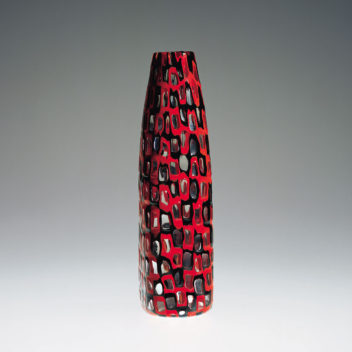
Tobia ScarpaOcchiVenini & C., 1960-1961
A vase crafted with the use of alternating pasta vitrea murrine.
One is black with a cristallo core, the other is red with a cristallo core.
12 5/8 in. high (32.1 cm)
Exhibitions:
1960, Milan, 12th Triennale;
1962, Venice, 31st Biennale Internazionale d’Arte; 2000, New York, Venetian Glass, Museum of Arts & Design; 2001, Milan, Murano: Vetri dalla Collezione Olnick Spanu, Spazio Oberdan.
Bibliography and comparative texts:
Venini, grey catalogue, n. 8526;
Domus, 1960, October, p. 166;
W. Neuwirth, 1987, n. 171;
La Verrerie…, 1988, n. 2;
F. Deboni, 1989, nn. 164, 165;
M. Karasik, 1989, n. 18;
H. Ricke, 1990, n. 379; R. Barovier Mentasti, 1992, n. 102; L’arte del vetro, 1992, n. 363; M. Heiremans, 1993, n. 240; M. Barovier, 1994, n. 43;
M. Barovier, R. Barovier Mentasti,
A. Dorigato, 1995, n. 147; F. Deboni, 1996, n. 224;
A. Venini Diaz de Santillana, 1996, nn. 219-221;
H. Ricke, E. Schmitt, 1996, nn. 153, 154;
M. Barovier, 1999, p. 261; A. Venini Diaz de Santillana, 2000, n. 186;
Olnick Spanu, 2000, n. 137;
Olnick Spanu, 2001, n. 172.

Tobia Scarpa 1935–
Tobia Scarpa, son of Carlo Scarpa, was born in Venice, where he graduated from the Istituto Universitario di Architettura di Venezia. In 1958, he was invited by Paolo Venini to collaborate in the furnace, following in the footsteps of his father, who had worked with Venini during the '30s and '40s. Tobia Scarpa designed new collections for Venini even after the death of its founder, creating refined blown glass pieces exemplified by the essential quality of their design. The most successful vessels were his large Battuti vessels, the Occhi and Murrine series, for which he reinterpreted ancient Roman glass techniques. As an architect and designer, together with his wife, Afra, he has collaborated with many companies—Cassina, B & B Italia, Flos, Molteni & C., to name a few—in creating works that belong to the best tradition of Italian design. During the '80s, he and his wife designed several glass collections for VeArt.

Venini & C. 1932–2001
In 1932, when both Martinuzzi and Zecchin left the company, Paolo Venini changed the name from Vetri Soffiati Muranesi Venini & Co. (V.S.M. Venini & Co.) to Venini & C.. Milanese architect Tommaso Buzzi became the new artistic director. After 1934, artistic direction was taken on by Carlo Scarpa, who designed most of the company's production through 1947. Side by side with Venini, who often intervened personally in design, Scarpa created numerous collections of objects characterized by refined colors. After World War II, Venini & C. sought numerous collaborations with artists such as architect Giò Ponti and the Swedish-born Tyra Lundgren. After 1948, Fulvio Bianconi, Massimo Vignelli, and Tobia Scarpa contributed significantly to the new direction of the company. Paolo Venini died in 1959 and his son-in-law, Ludovico Diaz de Santillana, took over the management of Venini & C. He not only worked personally as a glass designer but also continued the collaboration started by Paolo Venini with various artists and designers. Starting in 1960, many other designers collaborated with the company, like Thomas Stearns, Toni Zuccheri, Tapio Wirkkala, Laura and Alessandro Diaz de Santillana, James Carpenter, Dan Dailey, Richard Marquis, Benjamin Moore, and Toots Zynsky. In 1986, the de Santillana family left the company, selling their stock to the Ferruzzi group, which guaranteed the fine quality Venini was known for by hiring new designers such as Timo Sarpaneva, Marco Zanini, Ettore Sottsass Jr., Alessandro Mendini, Mario Bellini, Barbara del Vicario, and others. In 1988, Venini was acquired by Royal Scandinavian. Since 2001, Venini S.p.A. has been part of Italian Luxury Industries Group and is led by Giancarlo Chimento, Giuliano Tabacchi, and Giorgio Rizzo.
Tobia ScarpaOcchi, 1960-1961
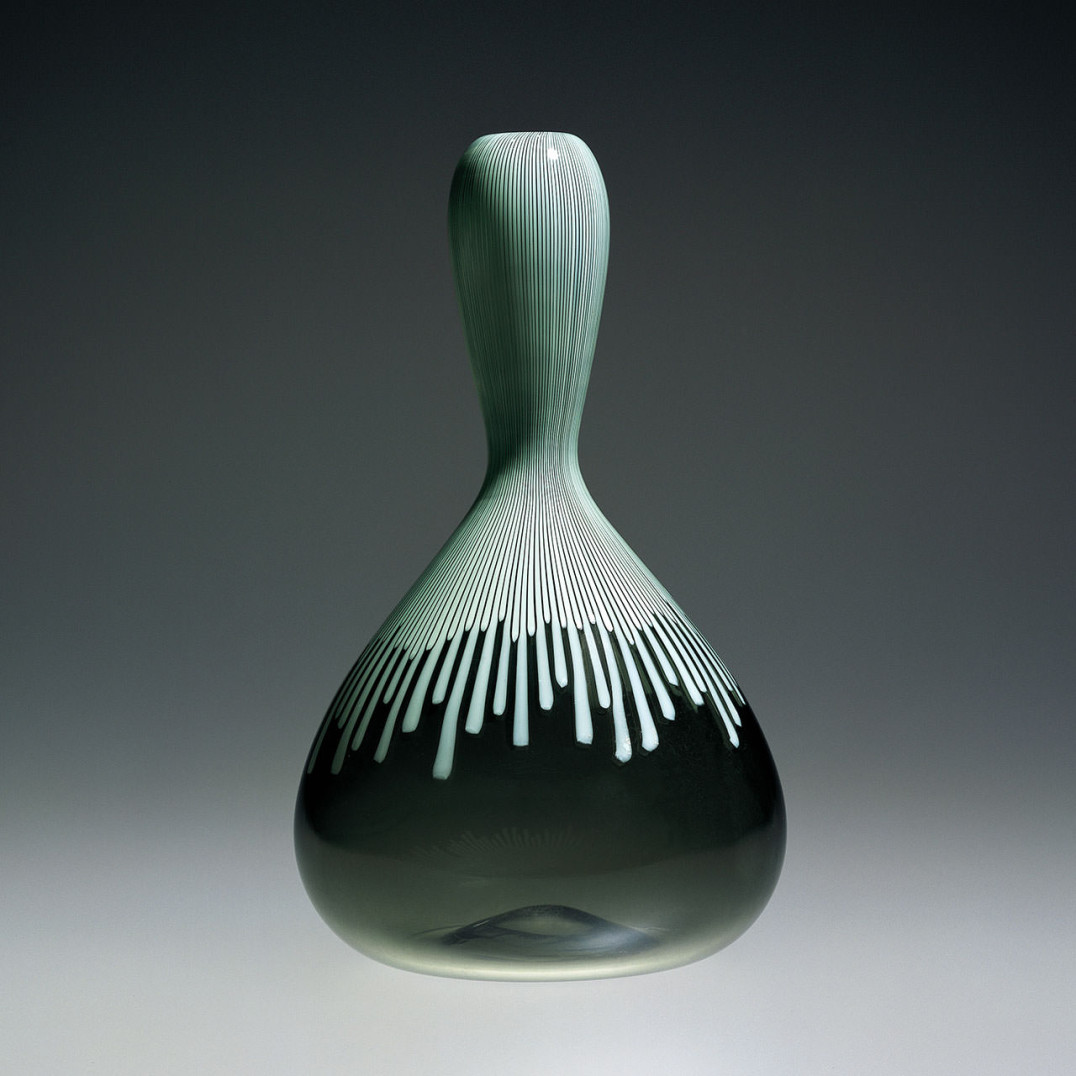
Ludovico Diaz de SantillanaCannette, 1962

Ludovico Diaz de SantillanaCannetteVenini & C., 1962
Vase in transparent amethyst
glass decorated with applied canes of green glass.
Acid stamped:
venini murano ITALIA.
11 1/2 in. high (29.2 cm)
Exhibitions:
1963, Venice, Exhibition of Murano glass, Opera Bevilacqua La Masa;
2000, New York, Venetian Glass, Museum of Arts & Design;
2001, Milan, Murano: Vetri dalla Collezione Olnick Spanu, Spazio Oberdan.
Bibliography and comparative texts:
Mostra del vetro…, 1963;
M. Heiremans, 1989, n. 217;
F. Deboni, 1989, n. 169;
A. Venini Diaz de Santillana, 1996, n. 234; A. Venini Diaz de Santillana, 2000, n. 198;
Olnick Spanu, 2000, n. 134;
Olnick Spanu, 2001, n. 169.
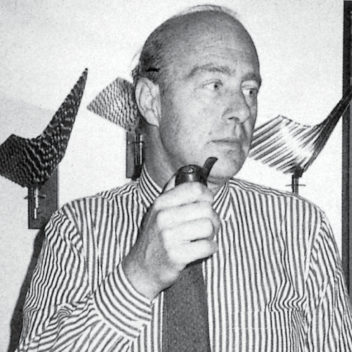
Ludovico Diaz de Santillana 1931–1989
Born in Venice, Laura Diaz de Santillana attended the School of Visual Arts in New York. After working as a graphic designer at the design firm of Vignelli Associates in 1976, she returned to Italy and began an active collaboration with Vetreria Venini & C., founded by her grandfather, Paolo Venini. At the workshop, managed with a spirit of great openness by her father, Ludovico Diaz de Santillana, her work brought her in close contact with the many Italian and foreign artists who came to the furnace in those years. During that period, she used the techniques of Murano to create refined works with unusual colors, among which the plates in vetro mosaico deserve particular mention. From 1985 to 1993, she was the designer and artistic director of Eos and later worked as designer for Rosenthal and for Ivan Baj. Further developing her own artistic identity through the creation of original works, lately she has focused her attention on the sculptural qualities of the material, which is often finished in singular textures. De Santillana's meditated study of color has produced original solutions. She has participated in numerous exhibitions in Europe, the United States, and Japan, winning widespread consensus. Several of her works have been acquired by public and private collections such as the Corning Museum of Glass, the Museum für Kunst und Gewerbe in Hamburg, and the Museo Vetrario di Murano.

Venini & C. 1932–2001
In 1932, when both Martinuzzi and Zecchin left the company, Paolo Venini changed the name from Vetri Soffiati Muranesi Venini & Co. (V.S.M. Venini & Co.) to Venini & C.. Milanese architect Tommaso Buzzi became the new artistic director. After 1934, artistic direction was taken on by Carlo Scarpa, who designed most of the company's production through 1947. Side by side with Venini, who often intervened personally in design, Scarpa created numerous collections of objects characterized by refined colors. After World War II, Venini & C. sought numerous collaborations with artists such as architect Giò Ponti and the Swedish-born Tyra Lundgren. After 1948, Fulvio Bianconi, Massimo Vignelli, and Tobia Scarpa contributed significantly to the new direction of the company. Paolo Venini died in 1959 and his son-in-law, Ludovico Diaz de Santillana, took over the management of Venini & C. He not only worked personally as a glass designer but also continued the collaboration started by Paolo Venini with various artists and designers. Starting in 1960, many other designers collaborated with the company, like Thomas Stearns, Toni Zuccheri, Tapio Wirkkala, Laura and Alessandro Diaz de Santillana, James Carpenter, Dan Dailey, Richard Marquis, Benjamin Moore, and Toots Zynsky. In 1986, the de Santillana family left the company, selling their stock to the Ferruzzi group, which guaranteed the fine quality Venini was known for by hiring new designers such as Timo Sarpaneva, Marco Zanini, Ettore Sottsass Jr., Alessandro Mendini, Mario Bellini, Barbara del Vicario, and others. In 1988, Venini was acquired by Royal Scandinavian. Since 2001, Venini S.p.A. has been part of Italian Luxury Industries Group and is led by Giancarlo Chimento, Giuliano Tabacchi, and Giorgio Rizzo.
Ludovico Diaz de SantillanaCannette, 1962
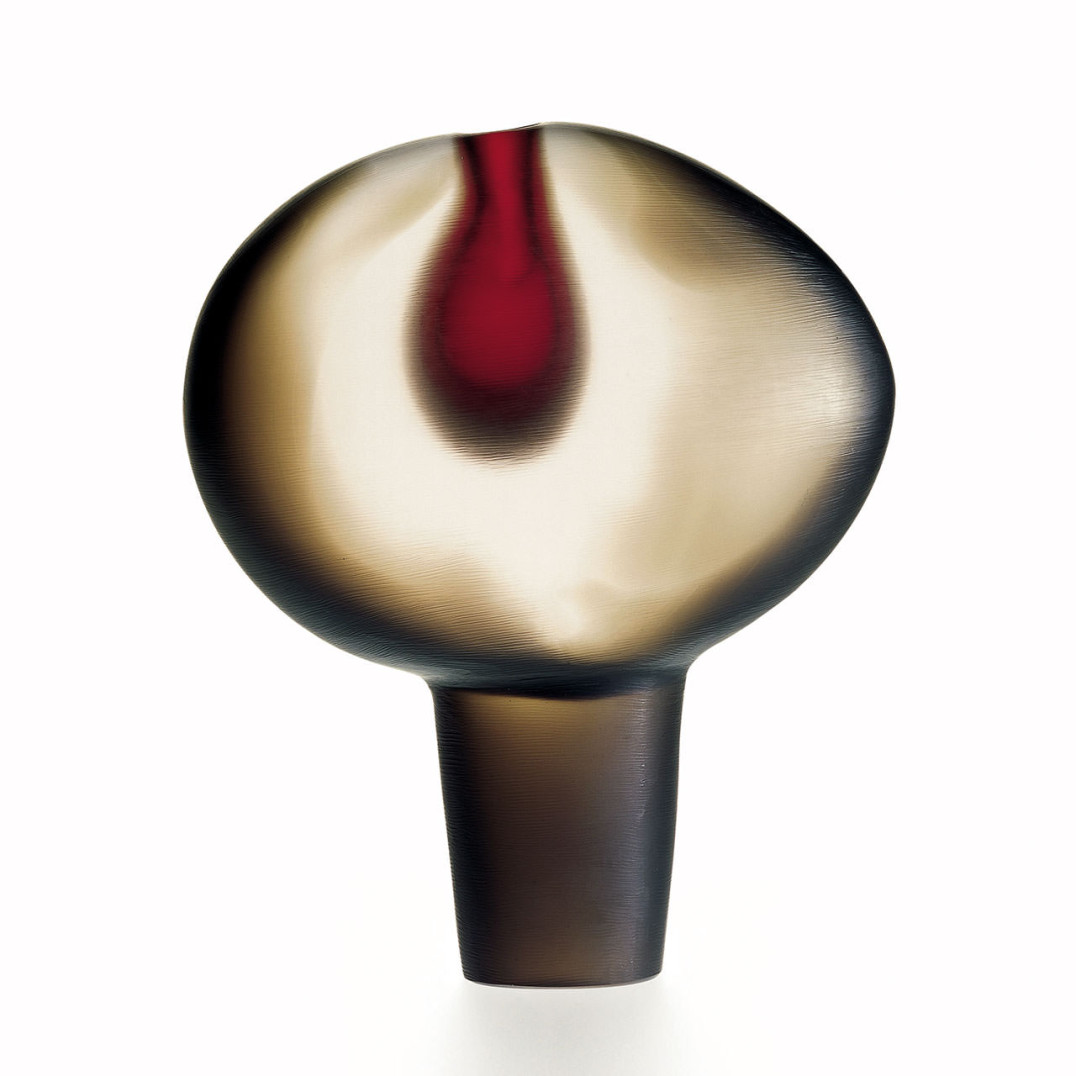
Alfredo BarbiniVetro pesante, 1962

Alfredo BarbiniVetro pesanteVetreria Alfredo Barbini, 1962
Sculptural vessel in pesante, heavy glass, sommerso in several layers of glass. The core of the sculpture is red, the finish a tight wheel-carved horizontal inciso.
10 1/2 in. high (26.7 cm)
Exhibitions:
1962, Venice, 31st Biennale Internazionale d’Arte;
2000, New York, Venetian Glass, Museum of Arts & Design;
2001, Milan, Murano: Vetri dalla Collezione Olnick Spanu, Spazio Oberdan.
Bibliography and comparative texts:
Catalogue 31st Biennale…, 1962, n. 210;
Mille anni…, 1982, n. 571;
M. Heiremans, 1989, n. 30;
M. Cocchi, 1991, n. 49;
M. Heiremans, 1993, n. 17;
M. Barovier, R. Barovier Mentasti,
A. Dorigato, 1995, n. 134;
M. Heiremans, 1996, n. 213;
H. Ricke, E. Schmitt, 1996, n. 252;
M. Barovier, 1999, p. 243;
Olnick Spanu, 2000, n. 133;
Olnick Spanu, 2001, n. 168;
A. Dorigato, 2002, p. 335.
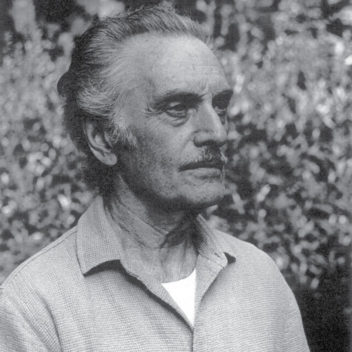
Alfredo Barbini 1912–2006
Glassblower, designer, and entrepreneur Alfredo Barbini was born in Murano and began working with glass while very young. At seventeen and a half, following a brief apprenticeship, he became a glass maestro; first at the Cristalleria Franchetti and then at the S.A.I.A.R. Ferro Toso. After 1932, he worked at the Zecchin-Martinuzzi furnace with the sculptor Napoleone Martinuzzi, and began a collaboration that would last through 1936. This would prove to be fundamental to his artistic development, especially in regard to sculpture in solid massiccio glass. In 1937, he became a partner at V.A.M.S.A. and was the primo maestro of the main team of the furnace continuing his experimentation with thick glass and executing works designed by the artists Ermenegildo Ripa and Luigi Scarpa Croce. In 1946, he became partner and artistic director of the new furnace Gino Cenedese & C. With this furnace, he participated in the 1948 Biennale di Venezia, exhibiting a remarkable series of sculptures in corroso glass such as Torso and Collasso. In 1950, he opened his own furnace, Vetreria Alfredo Barbini, where he continued to experiment with the sculptural qualities of glass using materials and forms that are more and more essential. This can be seen in his series Pesci and Tulipani or in the Vetri Pesanti of the early '60s. Assisted by his son Flavio since 1968, Barbini continued working for several decades as maestro and artistic director of the furnace he created in 1950.
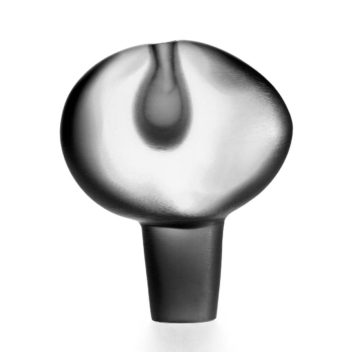
Vetreria Alfredo Barbini 1932–
Alfredo Barbini worked as an apprentice at S.A.I.A.R. Ferro Toso and the Società Anonima Vetrerie e Cristallerie di Murano. He also worked as a glassblower in furnaces such as Barovier Seguso & Ferro, V.A.M.S.A., and in particular, Gino Cenedese & C., where he served as the artistic director. In 1950, Barbarini opened his own furnace. Skilled in the hot-work manipulation of massiccio glass, to Barbini channeled his efforts towards researching the malleability of glass, as his preference for essential forms continued to grow. After the '60s, Flavio Barbini joined his father in both the administration of the company and product design. Today, the company is still one of the most important glassmakers in Murano.
Alfredo BarbiniVetro pesante, 1962
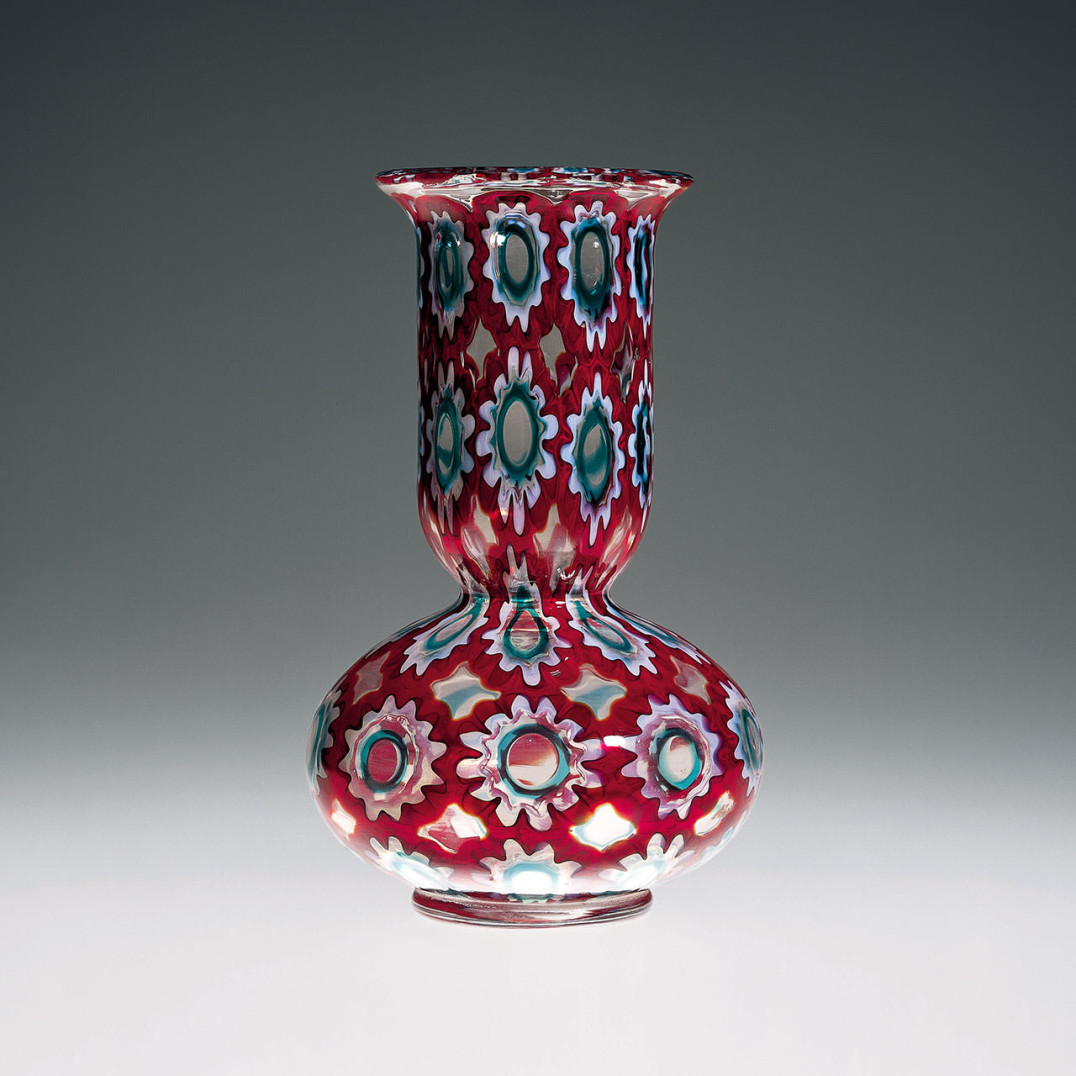
Ercole BarovierRotellato, 1970
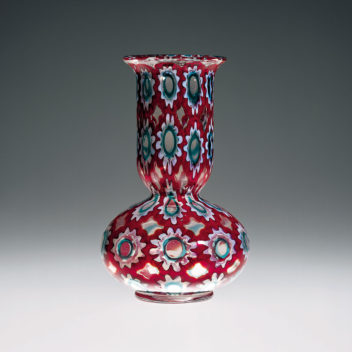
Ercole BarovierRotellatoBarovier & Toso, 1970
A footed vase composed of circular tessere a dentelli, with indentations in cristallo, blue, and red glass.
11 in. high (28 cm)
Exhibitions:
1970, Venice, 35th Biennale Internazionale d’Arte;
2000, New York, Venetian Glass, Museum of Arts & Design;
2001, Milan, Murano: Vetri dalla Collezione Olnick Spanu, Spazio Oberdan.
Bibliography and comparative texts:
A. Dorigato, 1989, n. 117;
M. Barovier, 1993, nn. 178, 179;
M. Barovier, R. Barovier Mentasti,
A. Dorigato 1995, n. 184;
F. Deboni, 1996, n. 50;
M. Heiremans, 1996, n. 255;
M. Barovier, 1999, p. 277;
Olnick Spanu, 2000, n. 132;
Olnick Spanu, 2001, n. 167.
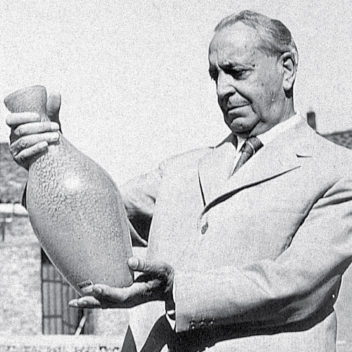
Ercole Barovier 1889–1974
Entrepreneur and designer Ercole Barovier was the son of Benvenuto Barovier. At age 30, he became a partner in his father's company, the Vetreria Artistica Barovier & C. After becoming its artistic director in 1926, he took over its management with his brother. He became sole proprietor in 1936, engineering the fusion between his own glass workshop and the S.A.I.A.R. Ferro-Toso. In 1942, the new company was renamed Barovier & Toso and Ercole maintained artistic direction until 1972. His first major successes date back to the '20s; first with the murrine vessels, then with totally original creations such as the Primavera glass collection of 1929-30. After the 30s, he dedicated himself entirely to experimenting with new multi-colored effects. In addition he perfected the colorazione a caldo senza fusione which he first used in 1935-36 to create the series Crepuscolo, Autunno Gemmato, Marina Gemmata, and Laguna Gemmata. Before World War II, he preferred soft shapes and rather thick materials, whereas in the postwar period his interest turned specifically to the field of traditional techniques, which he continued to reinterpret through his very last creations with the series A Tessere in 1972. In the '50s, his work distinguished itself, both for the vivid quality of its colors as well as for the singularity of the materials noted for the rawness of their surfaces like the barbarici. During the '60s and '70s, he gave new interpretations of his a tessere glass with the Dorici, Caccia, Rotellati, and other series, which were characterized by unusual color combinations.
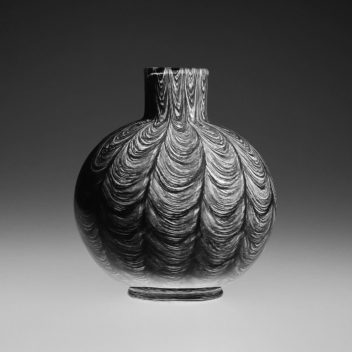
Barovier & Toso 1942–
In 1936, Ercole Barovier became partner of the S.A.I.A.R. Ferro Toso, forming Ferro Toso e Barovier. In 1939, it became Barovier Toso & C., and finally, in 1942, its name was changed to Barovier & Toso. Ercole Barovier remained artistic director of the company through 1972 and was succeeded by his son, Angelo, who was already a designer for the company. Beginning in the '80s and continuing through today, many have designers collaborated with Barovier & Toso. Among them are Matteo Thun, Toni Zuccheri, Renato and Giusto Toso, and Noti Massari. The company’s most recent productions have been created by designers like Roberto Caddeo, Marco Mencacci, Franco Raggi, Luca Scacchetti, and others. Barovier & Toso is currently directed by Angelo, his son Jacopo, and Giovanni Toso.